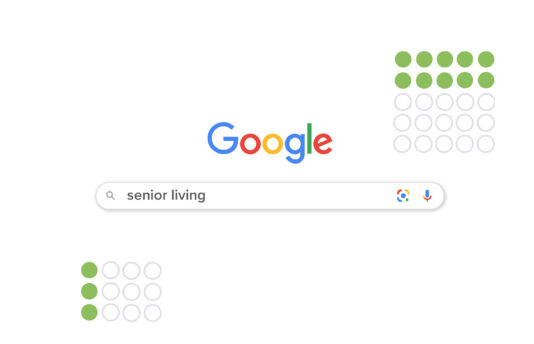Are you leaving the residents in your senior living community out of the sales process? If so, you’re missing out on one of the most powerful tools at your disposal. In a world where only three percent of consumers consider salespeople and marketers trustworthy, word of mouth (WOM), online reviews and testimonials are three exceptionally effective sales tactics.
All three focus on your satisfied residents—and their families—who can be your biggest cheerleaders and most productive salespeople of all. Think of leveraging residents and their families as walking billboards that can effortlessly convey what makes your community special, bring in more leads and close more sales.
Word of Mouth
Word of mouth is a simple concept: You use existing customers to bring in new customers. Your residents and their families are your spokespeople, both in and out of the community. When people buy a new product, they are most likely to turn to friends or family for recommendations. And what friends and family say carries weight: 83% of people surveyed say they completely or somewhat trust the recommendations of friends and family. So, WOM can be a very persuasive form of marketing.
The sway of WOM is there from the top of the funnel, when people are beginning to search for senior living options. Older generations are more inclined to rely on WOM for brand discovery, meaning their friends’ or families’ recommendations hold significant importance in the awareness stage of the buyer’s journey. About one-third of those 45–54 and almost 40% of those 55–64 say WOM is their main source of information about new brands and products.
While you can’t control what people say about your brand, you can take steps to make it positive. As in other industries, there’s no substitute for outstanding customer service, transparency and ethical behavior in senior living. Do more than what is expected. Offer unique services and programs. Listen and make improvements based on feedback. These things will pleasantly surprise people, and when people are pleasantly surprised by your brand, they will want to share their experience. According to Salesforce, 72% of customers will share their good experiences with other people.
Just don’t forget there’s a dark side to WOM: 96% of unhappy customers won’t complain to you but will tell 15 friends. So, paying attention to what’s being said about your community is also a must.
Reviews Matter
Almost 40% of those 55 and older say they trust online reviews as much as personal recommendations, so reviews can be as powerful as word of mouth for seniors looking for a retirement community.
A majority of those looking for senior care online are adult children, and they are very influenced by reviews: 89% of consumers aged 35 to 54 trust online reviews as much as personal recommendations.
Reviews can also help boost your search engine optimization. Online reviews are now the second most important factor for local pack ranking on Google and comprise as much as 10% of the criteria for how Google displays search results overall.
So, a critical part of your sales plan should be to request reviews from your residents—and their families. Did you know that more than 70% of people will write reviews when asked? You can ask for reviews in person or by email, social media and Google My Business. Be sure to also include links on your website to places where people can easily leave reviews.
Since adult children are often the decision-makers, don’t neglect them. Reviews from happy children and families are just as important as reviews from happy residents.
Respond to Reviews
Respond to all reviews, both positive and negative. Ignoring bad reviews tells prospects you don’t care about making customers happy.
When you get a bad review, first acknowledge the consumer’s dissatisfaction, and tell them you’re sorry they had a bad experience. Next, tell them you’d like more information. Finally, take the conversation offline. That prevents other people from jumping in and making further negative comments and allows you to address the issue 1:1.
When you make a mistake, acknowledge it. 85% of respondents to a ZDNet survey said when a business is transparent, they are more likely to give it a second chance after a bad experience. The study also found that lack of transparency causes people to try a different brand.
Of course, it’s also important to respond to positive reviews. Thank the reviewer warmly and sincerely. It’s worth it: A Harvard Business Review study found that when businesses respond to all reviews, they get more of them—and their ratings increase.
Get Testimonials
Testimonials differ from reviews, and they can increase conversions on sales pages by 34%. A major difference between reviews and testimonials is that testimonials are in your control. While you might get a bad review, you don’t have to worry about a bad testimonial. You choose the testimonials you want to post on your website and the people who give them.
Testimonials can be text, a text-image combination or video, but video performs best. Some 90% of customers say video testimonials helped them make buying decisions.
Try to make your testimonials stand out: Don’t simply record a resident sitting on a couch in front of the camera. That doesn’t tell anyone anything about living in your community. If you have a woodworking shop, record a video of a resident working on a project in the shop explaining their satisfaction in continuing to pursue one of their passions. If you have a robust gardening program, use the garden as a setting to talk to the resident gardeners surrounded by blooms. That way, residents not only talk about what they’re passionate about, but they show it, as well.
It’s All About the Stories
In a competitive industry, your community really needs to stand out from others. Storytelling is a great way to stand out and push people a little further down the path to becoming customers.
Since the beginning of time, humans have used stories to get information out, simplify concepts and make abstract information more solid. Stories give you a deeper connection with your target audience, drive engagement and make your brand more memorable.
Your residents have fascinating and compelling stories to tell, and you have the forum to amplify them. Use these stories to bring life to special occasions and observances. For instance, on International Women’s Day, interview one of your female residents who had a notable career or was involved in groundbreaking innovation. Or on Veterans’ Day, don’t just issue a standard “thank you” message. Instead, have a resident veteran talk about what Veterans’ Day means to him or her.
Think about your unique selling proposition and record residents talking about what drew them to your community. Or address a specific pain point, such as fear of moving to a new environment, using a resident’s story of how they were welcomed and became part of the community.
Address adult children’s concerns by creating content featuring people in the same demographic who can ease their worries and help provide peace of mind about the decision to move to a senior living community.
Now. Spread the Word.
Once you have some rave reviews, compelling testimonials and great stories, don’t just let them sit. Make graphics out of some of the shorter reviews and post them to Facebook and Instagram, which are great places for visual content. Link to your relevant testimonials in your email marketing so readers have something that shows AND tells them about living in the community. Share your stories on YouTube or your blog to raise awareness of what your community offers. Keep everything consistent to build a seamless multi-channel marketing effort using the largest and most effective resource you have—people.











